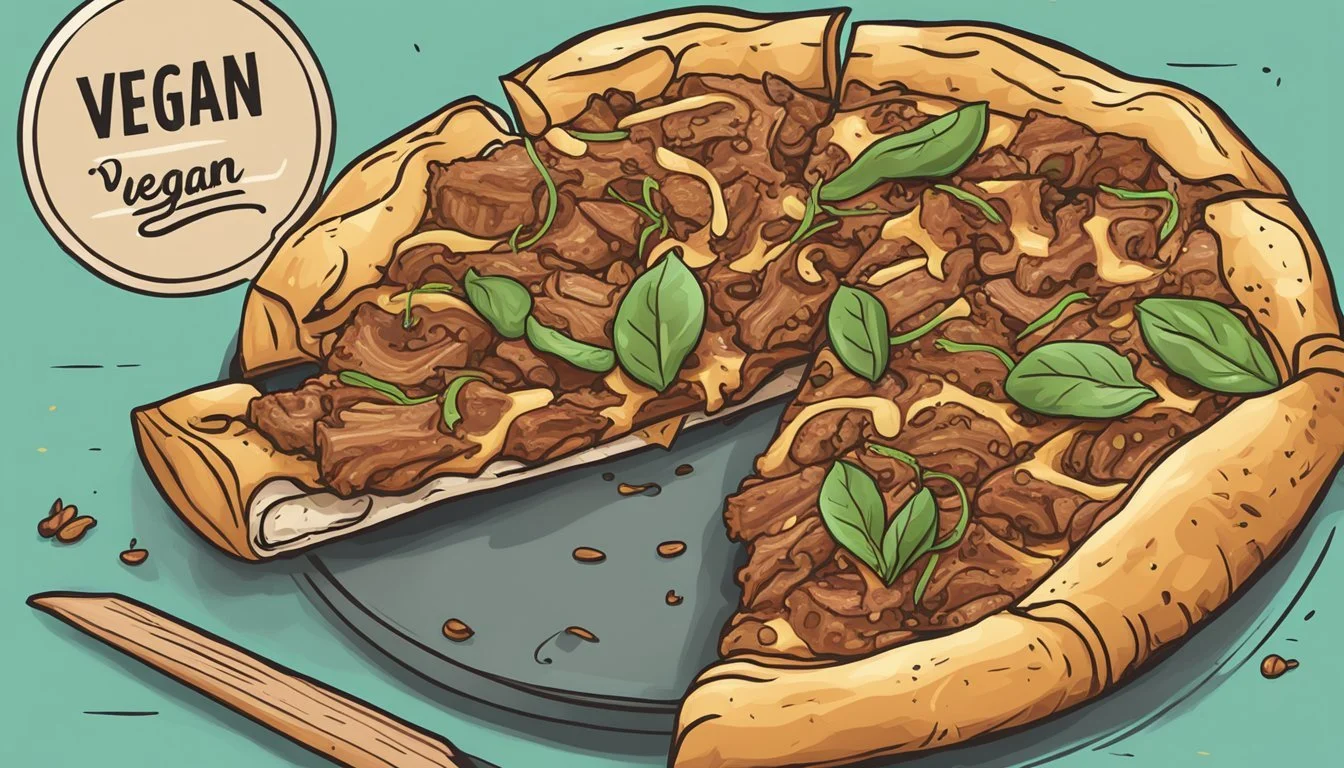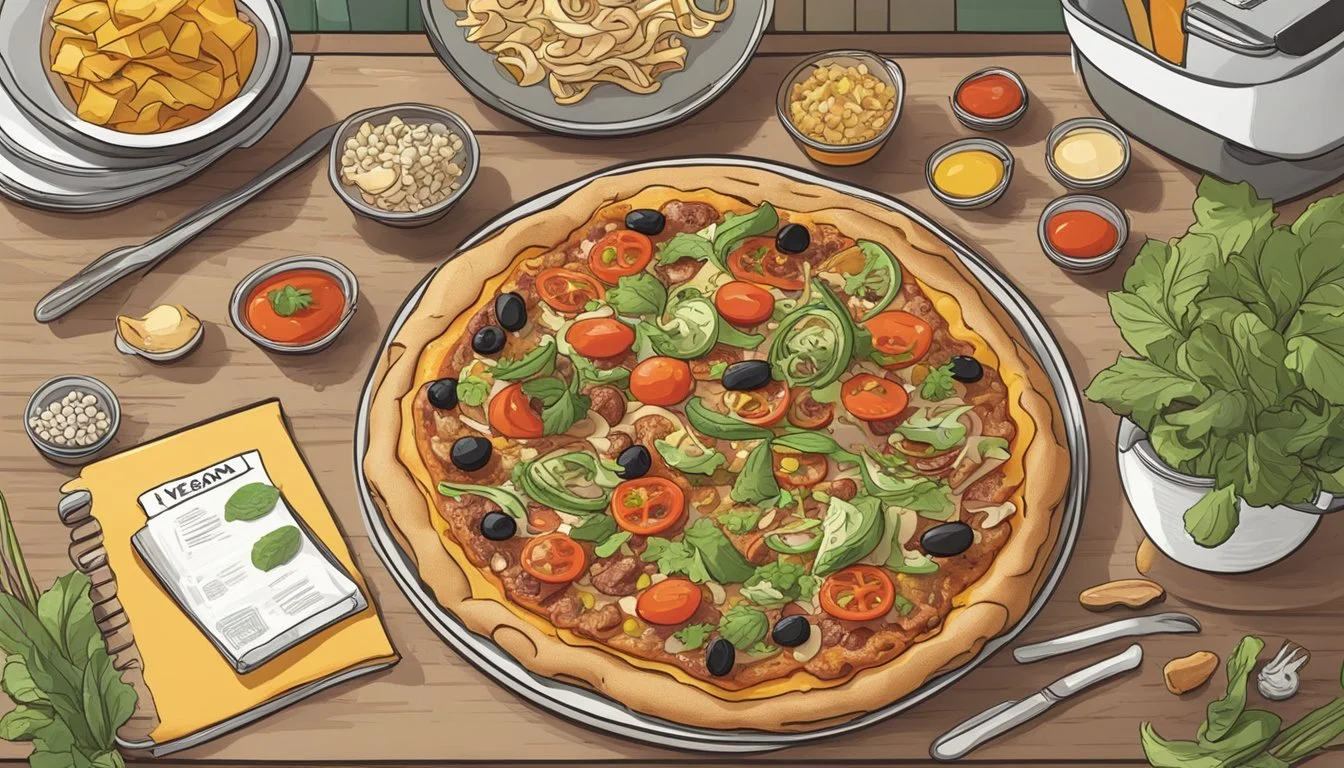Is Pulled Pork Pizza Vegan?
Exploring Plant-Based Alternatives
Pulled pork pizza (What wine goes well with pizza?) traditionally centers around a topping of slow-cooked pork that has been shredded or 'pulled' apart, and then often combined with barbecue (What wine goes well with barbecue?) sauce. Given that the main ingredient is pork, a meat product, classic pulled pork pizza is clearly not vegan-friendly, as veganism excludes all forms of animal products in favor of plant-based alternatives.
However, the rise of plant-based diets and the increasing demand for vegan options have led to innovative culinary adaptations. These adaptations include substitutes like jackfruit, which mimic the texture and flavor profile of pulled pork once cooked and seasoned. Vegan versions of pulled pork pizza use this fruit as a replacement, along with vegan cheeses and barbecue sauces that are free from animal products.
Understanding Veganism
Veganism is a dietary and lifestyle choice characterized by the abstention from animal products. Individuals who follow a vegan diet exclude meat, dairy, eggs, and all other animal-derived ingredients from their meals. The focus is on plant-based foods, which are rich in essential nutrients and can provide adequate protein when a balanced and varied diet is maintained.
A typical vegan diet might include:
Fruits and Vegetables: A wide variety provide vitamins and minerals.
Legumes: Beans, lentils, and peas offer protein and fiber.
Nuts and Seeds: These are good sources of healthy fats and protein.
Whole Grains: Such as brown rice and quinoa, essential for energy and nutrition.
Plant-based Milks and Yogurts: Often fortified with vitamins and minerals.
When considering the nutritional aspects of veganism, it's important to plan meals to ensure a sufficient intake of protein and other nutrients commonly found in animal products. Most plant-based proteins don't contain all the essential amino acids, so consuming a variety of protein sources is crucial for a balanced diet.
A vegan diet also extends beyond ingredients; it influences the choice of clothing, beauty products, and other consumer goods, with an emphasis on avoiding items made from or tested on animals.
In the context of a pizza, a vegan approach would swap traditional pork toppings with plant-based alternatives, such as jackfruit or tofu, which mimic the texture of pulled pork when prepared properly. Vegan cheese substitutes made from nuts or soy products, and crusts devoid of dairy or eggs, are additional modifications to align with vegan values. Veganism is rooted in ethical, environmental, and health considerations, promoting a sustainable and animal-friendly way of living.
Origin and Popularity of Pulled Pork Pizza
Pulled pork pizza is a culinary innovation that combines the hearty, smoky flavors (What wine goes well with smoky flavors?) of traditional BBQ pulled pork with the universally beloved pizza. Pulled pork, which entails slow-cooking pork until it can be "pulled" into shreds, pairs splendidly with the rich, savory taste profile of pizza, offering a satisfying contrast to the usual toppings.
The dish likely emerged from the American South where BBQ reigns supreme, and from there, it steadily gained popularity. With the versatility and popularity of pizza, it didn't take long for the topping to become a hit. This popularity is partly because the tangy and sweet flavors of BBQ sauce complement the yeasty pizza crust beautifully.
Social media platforms such as Instagram, Facebook, Twitter, and Pinterest have played a significant role in the rise of pulled pork pizza. Images and recipes of this savory dish often generate considerable engagement, inspiring food enthusiasts to try making it at home or seek it out at restaurants.
A characteristic of pulled pork pizza is the requirement for a high heat to replicate the crust that would traditionally be achieved in a commercial pizza oven. For homemade versions, enthusiasts advise preheating regular ovens to the highest temperature, often between 450° to 500°F, to achieve a golden and crunchy crust.
Through its adaptability and appeal, the dish has secured a place in the hearts of pizza fans around the globe. It suits a wide variety of occasions, from casual family nights to social gatherings, thus underscoring its popularity and endurance in the modern culinary world.
Ingredients and Their Vegan Status
As the landscape of culinary preferences continues to evolve, understanding the vegan status of ingredients in dishes like pulled pork pizza becomes essential. This section will provide clarity on the components typically used in such a dish and their potential vegan substitutes.
Traditional Pulled Pork Components
Traditional pulled pork is inherently non-vegan, as it is made from the slow-cooked shoulder cut of a pig. In a typical recipe, the meat is seasoned and cooked until it can be "pulled" into shreds.
Common Pizza Ingredients
A standard pizza usually comprises:
Crust: wheat-based dough that includes yeast, water, salt, and oil.
Cheese: predominantly mozzarella, which is a dairy product and not vegan.
Sauce: often a tomato-based sauce, it can vary in ingredients but is generally vegan.
Vegan Ingredient Alternatives
Vegan Pulled Pork: can be made from seasoned and cooked jackfruit or soy curls.
Vegan Cheese: alternatives include those made from nuts, soy, or other plant-derived proteins.
Vegan Pizza Dough/Crust: exists and is identical to traditional crust but ensures all ingredients, including sugar, are vegan.
Sauces and Flavor Profiles
Vegan sauces for pulled pork pizza merge:
BBQ Sauce: typically vegan, but homemade versions can ensure the use of vegan sugar and no animal by-products.
Flavor: enhanced using garlic, onions, smoked paprika, and other spices.
Additional Toppings and Garnishes
Popular toppings for additional texture and flavor on vegan pizza may include:
Vegetables: such as red onions, pineapple, or cilantro.
Vegan Coleslaw: a mix of lettuce and carrots in a vegan-friendly mayonnaise.
Vegan Parmesan: made from nutritional yeast, nuts, and seasoning.
Texture and Consistency Agents
Fiber: Jackfruit provides a meaty texture due to its high fiber content.
Brine: the water in canned jackfruit acts as a brine, helping to soften the fruit and infuse flavors.
Spices and Seasonings
Common spices used in vegan pulled pork pizza to mimic traditional flavors are:
Smoked Paprika: for a smoky touch.
Cumin and Chili Powder: to add warmth and depth.
Garlic Powder and Salt: for foundational savoriness.
Vegan Pulled Pork Alternatives
Pulled pork pizza can easily be adapted for a vegan diet by using plant-based alternatives that mimic the texture and flavor of pork. These substitutes offer a meatless solution while still providing a satisfying experience for those looking to enjoy a classic dish.
Jackfruit as a Substitute
Jackfruit has emerged as a popular choice for vegan pulled pork due to its fibrous texture, which closely resembles that of cooked pork. Specifically, young green jackfruit in its unripe form is used, as it is less sweet and more absorbent of flavors compared to ripe jackfruit. Often found canned, jackfruit can be drained and then prepared in a skillet or oven to create a perfect base for bbq jackfruit pizza.
Other Vegan Meat Substitutes
Apart from jackfruit, there are a variety of other plant-based proteins capable of standing in for pork on pizza. Tofu, when well-pressed and seasoned, can provide a hearty bite. Another notable meat substitute includes meatless vegan recipes utilizing soy or wheat gluten to create a chewy, meat-like texture that can be shredded and added to a pizza.
Preparing the Vegan Base
The procedure for preparing a vegan pulled pork involves sautéing the chosen substitute in a skillet with a bit of olive oil to enhance its texture. For a roasted effect, the seasoned base can be spread on a baking sheet and placed in an oven. This method adds a layer of texture that's particularly desirable on pizzas.
Flavor Enhancement Techniques
To achieve the savory, smoky flavor associated with traditional pulled pork, a range of spices and ingredients are utilized. Key seasoning components include smoked paprika, soy sauce, and onion powder. These ingredients, along with others like garlic and a quality barbecue sauce, help in creating a rich, complex flavor profile that elevates the overall taste of the vegan pulled pork.
Recipe and Cooking Instructions
Creating a vegan version of pulled pork pizza involves substituting traditional ingredients with plant-based alternatives. The recipe provided here will guide readers through the steps to prepare a vegan pulled pork pizza using jackfruit as the primary replacement for pork. Understanding the preparation of the jackfruit and the assembly of the pizza are crucial for achieving the desired flavors and textures.
Homemade Vegan Pulled Pork Pizza
Ingredients:
1 can (20 oz) young green jackfruit in brine or water
1 cup barbecue sauce (ensure it's vegan)
1 pre-made vegan pizza crust or homemade gluten-free dough
1 cup vegan cheese, shredded
1 small red onion, thinly sliced
Instructions:
Preheat the oven to 450°F.
Drain and rinse the jackfruit thoroughly, then pat dry. Shred the jackfruit pieces using a fork or potato masher until they resemble pulled pork.
In a pan over medium heat, sauté the jackfruit with half of the barbecue sauce until it is well-coated and heated through.
Spread the remaining barbecue sauce over the pizza crust, leaving a small border for the crust.
Evenly distribute the cooked jackfruit on top of the sauce.
Sprinkle vegan cheese over the jackfruit and top with red onion slices.
Place the pizza in the oven and bake for 12-15 minutes, or until the crust is golden and the cheese has melted.
Alternative Vegan Pizza Variations
BBQ Jackfruit Flatbread: Use a pre-made vegan flatbread as a base. Before assembling, toast it lightly in the oven for a crispier texture.
Gluten-Free Crust Option: Opt for a gluten-free pizza dough recipe if required. Make sure it is pre-baked if necessary before adding toppings.
Cheese Variations: Experiment with different types of vegan cheeses, such as mozzarella, cheddar, or a blend, to find the perfect melty texture and flavor.
Substitutions: Personalize your pizza with various toppings like vegan pepperoni, mushrooms, bell peppers, or olives. Adjust the amount of barbecue sauce to suit your taste preferences.
Each variation offers a unique twist to traditional pizza, while accommodating different dietary needs and preferences.
Serving Suggestions and Pairings
When considering the vegan alternative to pulled pork pizza, one can create a cohesive meal by focusing on complementary sides and pairing ideas.
Salads provide a refreshing contrast to the hearty pizza. A simple arugula salad dressed with lemon and olive oil, or a classic coleslaw with a vegan dressing can offer a crunchy and tangy balance.
For those looking for a more substantial side, sandwiches or burritos can incorporate similar flavors found in the pizza. One could opt for a barbecue jackfruit filling, which mirrors the smokiness of the pizza topping and creates unity across dishes.
Tacos and nachos laced with vegan pulled pork alternatives can also act as playful shareables that echo the central flavors of the meal. They serve as a fun and casual addition, bringing both variety and volume to the table.
For a weeknight dinner, efficiency is key. Consider a side such as sautéed vegetables — perhaps bell peppers and onions — or a quick vegan mac and cheese that can be whipped up while the pizza bakes.
Side Category Example Salads Arugula with lemon, Coleslaw Handhelds BBQ Jackfruit sandwiches, Burritos Shareables Pulled Pork-style Tacos, Loaded Nachos Weeknight Sides Sautéed Vegetables, Vegan Mac & Cheese
Consumers appreciate diverse textures and flavors. A side of crispy potato wedges or sweet potato fries can add a welcome crunch and sweetness. Lastly, don’t forget the possibility of a light soup to start, as it can offer a soothing lead into the meal.
Preservation and Storage Tips
When preserving vegan pulled pork pizza, the key is to maintain its texture and flavor. To store leftovers properly, one should place the pizza slices in an airtight container. If the pizza slices are stacked, it's recommended to separate them with parchment paper to prevent sticking.
For short-term storage, leftovers can be kept in the refrigerator. They should be consumed within 2-3 days to ensure freshness and to prevent spoilage. To reheat, an oven or toaster oven can be used to help retain the crust's crispness better than a microwave.
For longer-term storage, freezing is an option. Vegan pulled pork pizza should be frozen as follows:
Cool the pizza completely to room temperature to avoid condensation, which can lead to soggy crust when thawed.
Wrap individual slices in cling film or aluminum foil. Then, place them in a heavy-duty freezer bag, removing as much air as possible before sealing, to prevent freezer burn.
Store in the freezer for up to 1-2 months for best quality.
When ready to enjoy, one does not need to thaw the pizza; it can go directly from the freezer to the oven. Preheat the oven to about 375°F (190°C), then bake until it is heated through. This ensures the crust remains crisp and toppings are warmed properly.
Remember:
Airtight containers are essential to prevent odor transfer in the fridge.
Freezing in recommended portions makes for easier reheating.
Date and label freezer bags to keep track of how long the pizza has been stored.
Leveraging Social Media
Social media has become an indispensable tool for sharing and discovering a wide array of vegan recipes, including alternatives to pulled pork pizza. Platforms like Instagram, Pinterest, Facebook, and Twitter serve as hubs for culinary inspiration, community engagement, and recipe distribution among food enthusiasts.
Sharing Recipes on Instagram
Instagram thrives as a visual platform where vivid photography is key. Users can find a plethora of vegan pizza recipe posts, including jackfruit pizza variations that imitate pulled pork. To share recipes, one can use high-quality images and short, engaging videos. Hashtags such as #VeganPizza, #BBQJackfruitPizza, and #VeganRecipes are crucial to reach a wider audience.
Pinterest Inspiration and Ideas
Pinterest offers a wealth of creative vegan recipes with its intuitive mood board setup. Users can find and pin their favorite jackfruit pizza recipe ideas, broadening their culinary horizons. Infographics and step-by-step guides are popular, making complex recipes more approachable. Boards can be organized by themes such as "Vegan Pizza Night" to keep ideas neatly cataloged.
Engaging Facebook and Twitter Communities
On Facebook, users can join dedicated vegan groups where vegan recipes are frequently exchanged. They can share photos of their homemade BBQ jackfruit pizza, ask for tips, or provide feedback on others' creations. Meanwhile, Twitter serves as a rapid-fire forum for sharing quick tips or short recipes, engaging with vegan food influencers, and participating in relevant conversations using trending hashtags like #VeganEats.
Final Thoughts
Traditional pulled pork pizza, as its name suggests, centers around pork, which is not vegan. However, culinary creativity has given rise to a vegan counterpart that uses jackfruit as a pork substitute. Jackfruit is a tropical fruit that, when unripe, has a meaty texture and can absorb flavors well, making it ideal for mimicking the consistency and taste of pulled pork.
A vegan pulled pork pizza typically consists of the following elements, making it a satisfying meal for those following a plant-based diet or looking to decrease meat consumption:
Base: A vegan pizza dough, homemade or store-bought, provides the foundation.
Sauce: A layer of barbecue sauce adds a tangy and smoky flavor.
Toppings: Shredded jackfruit, prepared with seasonings and perhaps additional barbecue sauce, along with vegan cheese, and occasionally unconventional toppings like corn for added texture and sweetness.
Finish: Some recipes might suggest a final garnish with fresh ingredients such as diced red onions or a sprinkle of fresh herbs for a pop of color and flavor.
In terms of nutrition, a jackfruit pizza can be a healthier alternative to conventional meat pizzas, often lower in saturated fat and cholesterol. While its flavor profile may differ from that of pork, jackfruit provides an enjoyable experience with a similar mouthfeel.
The burgeoning vegan options like this pizza choice demonstrate how far vegan cuisine has come, offering flavorful and accessible alternatives that continue to broaden the plant-based food landscape. They cater to a diverse crowd, from strict vegans to curious omnivores, while ensuring that no compromise is made on taste or texture.
Expert Tips and FAQ
Nutrition Tips:
For those looking for a healthier version, they can opt for whole grain or gluten-free pizza bases to enhance the nutritional profile. Additionally, using homemade BBQ sauce can reduce sugar and preservatives. One can also increase the fiber content by adding more vegetable toppings.
Texture and Flavor:
Achieving the right texture for vegan pulled pork is crucial. One should shred the jackfruit properly to mimic the consistency of pulled pork. For flavor, they should season the jackfruit well and sauté it until tender before adding BBQ sauce.
Vegan Recipes Variations:
One can customize their vegan pizza with a variety of toppings. Some popular additions include:
Vegetables: Bell peppers, spinach, mushrooms
Cheeses: Vegan mozzarella, cashew cheese
Extras: Pineapple chunks, vegan parmesan
Ingredient Purpose Variation Jackfruit Meat substitute Substitute with mushrooms or tofu BBQ Sauce Flavor base Homemade or store-bought, spicy or sweet Vegan Cheese Creaminess and richness Different types, brands, or homemade
FAQs:
Can I make pulled pork pizza without jackfruit?
Yes, mushrooms or shredded tofu are great substitutes for jackfruit.How can I ensure my pizza isn't soggy?
Use a preheated pizza stone and ensure the jackfruit mixture is not too wet before applying to the pizza base.Is vegan cheese as melty as regular cheese?
Some vegan cheeses may not melt the same way as dairy cheese, but many brands have perfected the meltability factor. Reading product reviews can help choose the right brand.How long should I cook vegan pulled pork pizza?
Cook the pizza until the edges are golden-brown, typically around 15 minutes at 425 degrees F.










